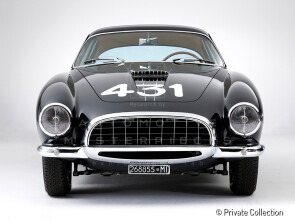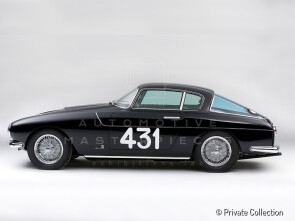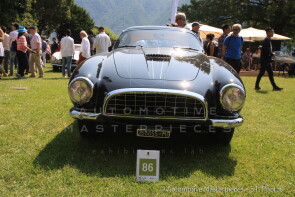
1954 Fiat 8V coupé speciale Gran Lusso
ON/OFF
Why am I an Automotive Masterpiece?
L. Limited edition cars
no. 10 manufactured
In the postwar period, Fiat was working on an eight-cylinder engine internally known as Tipo 106. The engine was originally designed by Dante Giacosa for a luxury sedan, but that project was stopped. Rudolf Hruska, at the time working at the S.I.A.T.A., was given the task to design a car around the V8 engine. The development took place in absolute secrecy. As not to stress the experimental department of Fiat, production of the chassis was also taken up by S.I.A.T.A. Styled by chief designer Fabio Luigi Rapi, the Fiat 8V or “Otto Vù” was presented to the Italian press in February 1952 and first exhibited the following March at the Geneva Motor Show. The car shapes saw several changes in time: the prototype used an art deco grill extending into the hood which initially characterized the examples of the first series. A second series was made featuring four headlights with some of the later cars having a full-width windscreen. A high-performance coupé, destined to compete in the GT class: the 2-liter 8V model was a departure from the usual Fiat production. It was really welcomed by Italian private drivers, it inspired the tuners and it was, in a word, the car to beat in the 2-liter class, also thanks to the special versions built by Zagato or Siata. The Fiat V8 had a 70° V configuration of 1996 cc of displacement, at 5600 rpm the engine produced 105 hp in standard form with double two-barrel Weber 36 DCS carburetors, giving a top speed of 190 km/h. Some engines were fitted with two huge four-throat Weber 36 IF4/C carburetors offering 120 hp, but the intake manifold was very rare. The Fiat 8V is the only eight-cylinder built by Fiat. The engine was connected to a four speed gearbox. The car had independent suspension all round reworking the Fiat 1100 ones and drum brakes on four wheels. As the body was welded to the chassis it was a semi-unitary construction. Only 114 of these high-performance coupés had been produced, 64 of them with a “Fiat Carrozzerie Speciali” body, 34 first series and 30 second series. It was made available anyway in different body styles, offered by the factory and by various coachbuilders like Zagato, Pinin Farina, Ghia and Vignale. The production ceased in 1954.
The bare chassis Fiat 8V no. 106*000066* with engine no. 000136 left the factory on January 8, 1954, destined for the Alfredo Vignale & C. coachbuilder. The engine was in standard set-up, while the gearbox had the benefit of 5 speed instead of 4. Vignale was responsible for the bodywork of ten of the 114 Fiat 8Vs made, as well as three of the Siata 208 CS derivatives. The coachbuilder did not produce a small series but, in his creative and exuberant tradition, developed a remarkable variety of stylistic themes. He created only one spider on this basis and nine coupés with sporty "flamboyant" lines. All these creations were born from the imaginative pencil of Giovanni Michelotti, who was then working for the Turin coachbuilder. Some examples were more basic, especially intended for sporting use; others were true show cars, with innovative and provocative lines, such as the famous "Demon Rouge" (chassis no. 106*000072*). The example with chassis no. 106*000066* is an extraordinary result of dynamic and formal balance. Beautiful and elegant to display, but ready to race. And this was, precisely, its fate. Counted among the 10 Fiat 8V Vignale designed by Michelotti, the car is, in fact, a one-off for its design with a very particular fastback line of its rear. It was not a “true” racing car as the Zagato 8Vs were, yet it featured a few very sporting characteristics: it had twin quick-filler caps build in the rear window and the previously mentioned 5-speed gearbox. The car was named “Fiat 8V coupé speciale Gran Lusso” in Michelotti's original drawings, which are preserved and have been exhibited recently by the Archivio Storico Michelotti, although it was introduced as Fiat 8V “Tipo Mille Miglia 1955” for its debut on April 20, 1955, at the XXXVII Salone Internazionale dell'Automobile in Torino. The car was exhibited in the Vignale stand but left the show ahead of the closing day, as it lined up on April 30, 1955, on the starting line of the Mille Miglia in Brescia. The stylish Vignale OttoVu in its dark blue livery was an unusual sight at the start; it was driven by the owner Mario Bonacina alone, under the aegis of Scuderia Madunina team. Unfortunately, the race ended in a withdrawal. The car was owned by enthusiasts in the following years and, at the beginning of the 1990s, it was brought to the United States, where a Chevrolet engine was temporarily installed (for unknown reason). In 2011 it was exhibited, in pre-restoration conditions at the "Concorso Italiano" of Carmel by the Sea. But in 2016 it is in stunning conditions, after a complete restoration, at the Pebble Beach Concours d'Elegance where it qualified 3rd in class. The following year it took part in the Villa d'Este concours. The car, perfect and with the original engine, has been published in several books, including Mille Miglia's Chassis - The Ultimate Opus Volume III, by Sandro Binelli, published by Automotive Masterpieces.






